Which Family Did Carnivorous Placental Mammals Evolve From
Special Outcome: Transitional Fossils
- Original Scientific Article
- Open Access
- Published:
Dimetrodon Is Not a Dinosaur: Using Tree Thinking to Empathise the Aboriginal Relatives of Mammals and their Evolution
Evolution: Pedagogy and Outreach volume two,pages 257–271 (2009)Cite this article
Abstruse
The line of descent that includes all living mammals extends back in fourth dimension over 300 million years. Many of the aboriginal relatives of mammals that fall along this line are very different in appearance from living mammals and are frequently mistaken for reptiles such equally dinosaurs. This misconception is reinforced past the fact that these animals are often referred to as "mammal-like reptiles," a term reflecting outdated methods for classifying organisms. In reality, these aboriginal mammal-relatives, known as synapsids, are more closely related to living mammals than they are to whatever reptiles. Evolutionary copse, which depict patterns of descent from common ancestors among organisms, are very useful for understanding why this is the case and for reconstructing the evolutionary histories of many of the unique characters found in mammals. Hither, I provide an introduction to evolutionary copse and their implications for understanding the relationships between mammals, synapsids, and reptiles. This is followed past a review of synapsid diversity and a word of how evolutionary trees tin can be used to investigate when in synapsid history unlike mammalian characteristics offset appeared.
Introduction
The sail-backed carnivore Dimetrodon (Fig. 1) ofttimes can exist found on the pages of dinosaur books and lurking amongst the plastic dinosaurs for sale at museum gift shops. Nevertheless, Dimetrodon is not a dinosaur; it became extinct about 60 meg years before the first dinosaurs evolved (almost the same corporeality of fourth dimension that separates humans from Tyrannosaurus rex), and it is more closely related to living mammals, including humans, than it is to any extinct or living reptile. The idea that Dimetrodon is non a dinosaur merely a mammal relative instead, is familiar to idea to vertebrate paleontologists: It was outset formulated in the 2d half of the nineteenth century (Cope 1878) and is well supported by diverse types of prove. Dimetrodon belongs to the array of fossil vertebrates that document in stunning detail the origin of mammals and the evolution of many mammalian characteristics such as a single lower jaw bone, complex teeth for chewing, a novel jaw muscle anatomy, large brains, and 3 tiny center ear bones. Yet, many people, ranging from college students to my friends and family to visitors at The Field Museum are surprised to acquire that Dimetrodon is not a dinosaur only part of our family unit tree. Dinosaur Dimetrodon is a persistent and widespread misconception. No wonder a T-shirt sold at the annual coming together of the Lodge of Vertebrate Paleontology features an angry Dimetrodon shouting, "I am not a dinosaur!"
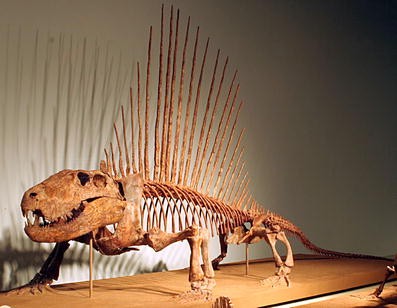
Skeleton of Dimetrodon. Dimetrodon is one of the best-known not-mammalian synapsids and is often mistaken for a dinosaur. This skeleton is on display at The Field Museum in Chicago
Dimetrodon is a fellow member of the large grouping of terrestrial vertebrates or tetrapods known every bit the Synapsida. Synapsids include all living mammals as well every bit a diverse range of extinct relatives extending back to the latter parts of the Carboniferous Menses of Earth history, about 305 million years ago. They are justifiably well known as one of the dandy evolutionary sequences preserved in the fossil record, illustrating the evolution of mammals from an ancient, somewhat cadger-like ancestor. The nature of this transition has been reviewed by a number of authors at differing levels of complexity and particular (e.thou., Hopson 1987, 1991, 1994, 2001; Hotton 1991; Rubidge and Sidor 2001; Kielan-Jaworowska et al. 2003; Martin 2004; Benton 2005; Kemp 2005; Prothero 2007), and my goal is non to only repeat the cloth available in those works. Instead, I will discuss two perhaps more primal issues that I believe frequently lead to confusion about the synapsid fossil record and how it informs paleontologists about the evolution of mammals. In both cases, evolutionary trees, which show how dissimilar organisms are related to i another, are key for organizing information and gaining deeper agreement.
The start issue concerns the human relationship betwixt mammals and other, and so-chosen not-mammalian synapsids, too as the relationship between Synapsida equally a whole and other groups of tetrapods. Pop treatments oft are not clear on the fact that non-mammalian synapsids differ from reptiles and why this is the instance. Imprecise and out-dated language which does not reflect electric current scientific thinking, such equally "mammal-like reptile" or "reptile-to-mammal transition", as well oft creeps into the give-and-take. When combined with the fact that many early synapsids, including Dimetrodon, superficially appear more than reptilian than mammalian, these problems obscure the true nature of some synapsids and their evolutionary significance. Therefore, I will endeavor to clarify where synapsids like Dimetrodon fall on the great family tree of life, how we know they vest in that location, and why their position means that they are not reptiles or dinosaurs.
The 2d topic I will accost is synapsid diversity and how it relates to the evolution of mammals. Considering the synapsid fossil record provides such a detailed view of the evolution of mammals, synapsid diversity is frequently portrayed equally an almost linear sequence, with each member of the sequence possessing a greater number of mammal-like features than the concluding. Nevertheless, such linear sequences are rarely accurate (meet MacFadden 1992 and Prothero 2007 for discussions of "classic" examples of linear evolution in horses and hominids that have been shown to be inaccurate), and this is truthful for synapsids. Synapsids existed for over 80 million years before the first mammals evolved, and during this time, non-mammalian synapsids evolved a fascinating array of shapes, sizes, and ways of life. These forms include large sabre-toothed carnivores, herbivores with turtle-like beaks, carnivores and herbivores with tall sails on their backs, specialized burrowers, small weasel-similar carnivores, hippo-sized herbivores with thickened skulls that may take been used for head-butting, and even a cannibal species that might have been venomous. This diverseness is sometimes overlooked because much of it is peripheral to the evolution of mammals. At the same time, its existence tin can atomic number 82 to questions and defoliation. For case, if Dimetrodon is our relative, and it had a sail on its back, does that hateful our direct ancestors did as well? To answer this question, I volition depict how evolutionary trees tin can be used to infer where in synapsid history item mammalian characters evolved, as well as to recognize when a feature of interest represents an evolutionary innovation peculiar to a specific subgroup of synapsids, and therefore is non of direct relevance to the development of mammals.
Evolutionary Copse and Synapsids or Why Mammal-similar Reptile is a Misnomer
The Basics of Evolutionary Trees
Dimetrodon and other not-mammalian synapsids often are referred to as mammal-similar reptiles, and the evolution of mammals from an before synapsid ancestor is sometimes described as the reptile-to-mammal transition. These phrases are misleading because they imply that not-mammalian synapsids are somehow akin to living reptiles, such every bit lizards, crocodiles, or snakes, and that reptiles are ancestors of mammals. Both of these ideas are incorrect, and the easiest fashion to see why this is the case is to consult an evolutionary tree or phylogeny.
Evolutionary copse have existed as long as the science of evolutionary biology itself. Famously, the simply effigy in Darwin's On the Origin of Species (1859) is an evolutionary tree. In the last 4 decades, the utilise of phylogenies as a framework for testing hypotheses and answering questions (and so-chosen tree thinking) has revolutionized many areas of biology and paleontology, and information technology is now a central part of the biological sciences (O'Hara 1988, 1997; for a historical treatment of some of the debates surrounding the rise of tree thinking, come across Hull 1988). Accompanying this revolution has been a fundamental shift in how scientists allocate organisms, and this in turn has rendered terms such equally mammal-like reptile obsolete.
At their most bones, evolutionary trees are diagrams that depict how recently 3 or more organisms shared a mutual ancestor (a useful introduction to phylogenies and tree thinking tin can be found in Gregory 2008). For example, in the simple phylogeny depicted in Fig. ii, we can see that humans and cats share a common ancestor because the branches of the tree leading up to them connect at their base (node five). Nosotros also can encounter that crocodiles and turtles share a mutual ancestor because their branches connect at their base (node 4). Annotation, however, that the connection point (or node) between the branches leading up to turtles and crocodiles on the one hand, and cats and humans on the other, lies farther down the tree, at node 3. This implies that cats, humans, turtles, and crocodiles all share a common antecedent (node three), but that this ancestor is older than the common antecedent of turtles and crocodiles (node iv) or the common antecedent of cats and humans (node five). In other words, the phylogeny tells us that cats and humans share a more than recent common antecedent with each other than either does with crocodiles or turtles, and that considering of this more recent common ancestor, cats and humans are more closely related to each other than either is to turtles or crocodiles. Using the aforementioned logic, we can see that cats, humans, turtles, and crocodiles all share a more recent mutual ancestor (node 3) with each other than any does with salamanders and that salamanders, crocodiles, turtles, humans, and cats share a more than contempo mutual ancestor (node 2) with each other than whatsoever does with lungfish. Note that in all of this give-and-take, the relationships of item organisms are always referred to relative to at least one other organism. This is because phylogenetic relationships are ever relative. In other words, if we have only two organisms or groups, nosotros tin only state that they share a common ancestor, but we cannot land whether that common antecedent is recent or afar. Once we add in at least ane more organism or group, all the same, we have a reference point that allows us to state that two of the organisms share a more than recent common ancestor with each other (i.e., they are more closely related to each other) than either does with the third.
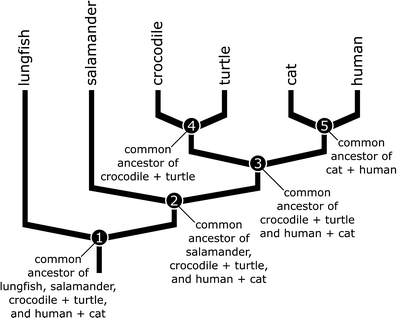
An evolutionary tree or phylogeny depicting the patterns of shared common ancestry betwixt lungfish, salamanders, crocodiles, turtles, cats, and humans. The connection points between branches or nodes represent the almost recent common ancestors of the animals establish on the branches they connect. See text for details
An important question to ask at this bespeak is how do we reconstruct the patterns of descent from common ancestors that are represented by an evolutionary tree? Later all, we cannot see the relationships between different organisms directly. The answer is that scientists infer patterns of relationship based on the distribution of characters among a prepare of organisms of interest. Characters used in this process can take many forms, including skeletal features, aspects of soft tissue anatomy at both the microscopic and macroscopic levels, and DNA sequences. Typically, a big amount of graphic symbol data volition be collected, and so a phylogeny will be sought that all-time explains the evolution of the greatest number of characters given a specific optimality benchmark, such equally minimizing the number of hypothesized evolutionary changes or the all-time fit to an independently derived model of how DNA sequences modify over time (technical data on how phylogenies are constructed tin be found in Kitching et al. 1998; Felsenstein 2004, and Huelsenbeck and Ronquist 2005). Special attention is unremarkably given to characters that all members of a particular grouping inherited from their most recent common antecedent because those characters are particularly useful for recognizing if newly discovered organisms are members of that group. So, in a sense, the characters organisms possess are something like tags indicating who their ancestors were, and scientists increment the likelihood that they have reconstructed an accurate evolutionary tree by finding the tree that best explains the evolution of the greatest number of characters.
The spread of tree thinking has had a profound effect on taxonomy and systematics, the sciences concerned with describing and naming species, and the placing of those species into larger named groups of organisms. Specifically, scientists now almost always endeavor to recognize and name groups of species that are based only on patterns of common ancestry discovered through the construction of phylogenies, whereas older methods frequently conflated patterns of beginnings, the presence or absence of supposed "key" characters, and qualitative notions of how advanced different species were [the PhyloCode (Cantino and de Queiroz 2007), a proposed new set of rules for amalgam names for organisms, represents 1 of the most fully developed results of this shift]. For example, Kielan-Jaworowska et al. (2003) recently defined mammals as "[the group] defined by the shared common ancestor of Sinoconodon, morganucodontans, Monotremata, Marupialia, and Placentalia, plus any extinct taxa shown to be nested with this [grouping]..." (p.2), a definition based on patterns of shared ancestry that are shown in a phylogeny (Fig. iii). In contrast, older definitions such as that of Simpson (1960) focused on the possession of detail characters, such as a single jaw os or the presence of three middle ear bones, with less concern for whether the animals grouped together nether such a definition included all descendants of a recent common ancestor. This methodological change is especially important in the case of non-mammalian synapsids. Under older classification schemes, these animals were grouped with the reptiles because they lacked supposedly key mammalian characters, despite the fact that they are more closely related to mammals than to whatever reptiles. This is why non-mammalian synapsids often appear in older works describing the morphology, origins, and relationships of reptiles (e.g., Romer 1956; Carroll 1969a, b, 1970).

Simplified phylogeny of synapsids demonstrating how the definition provided by Kielan-Jaworowska et al. (2003; the common antecedent of Sinoconodon, morganucodontans, monotremes, marsupials, and placentals, plus any species nested within this group) delimits mammals. The definition uses patterns of common ancestry found in the phylogeny to denote which animals vest to the group Mammalia and which animals fall outside of that grouping. Names shown in bold are those used in the definition of Mammalia
Where Do Synapsids Fit?
If we consider a phylogeny of living tetrapods and their close relatives (Fig. 4a), we can run across that tetrapods are comprised of at least three and possibly four main groups, depending on whether caecilians, worm-like tetrapods establish in the torrid zone, are more than closely related to frogs and salamanders, as traditionally thought, or if they share a more contempo common antecedent with mammals and reptiles (eastward.chiliad., compare the copse of Ruta and Coates 2007 to that of Anderson et al. 2008). This dubiety notwithstanding, the tree makes clear the relationships of living synapsids and reptiles: The three living synapsid groups, montreme mammals (platypus and echidnas), marsupial mammals (kangaroos, koalas, possums, and their relatives), and placental mammals (dogs, bats, whales, horses, humans, and their relatives) all are more closely related to each other than they are to any reptiles (i.eastward., they share a more recent common antecedent with each other than whatever living reptiles). In other words, reptiles and synapsids (represented among living animals past mammals) represent two singled-out lines of descent from a mutual ancestor, and neither group is straight ancestral to the other. To claim that reptiles are bequeathed to mammals would be similar to challenge that your cousin is ancestral to y'all. Both you and your cousin share mutual ancestors, your grandparents, but separate lines of descent lead from them to you and your cousin, one passing through your aunt or uncle, the other passing through your father or mother.
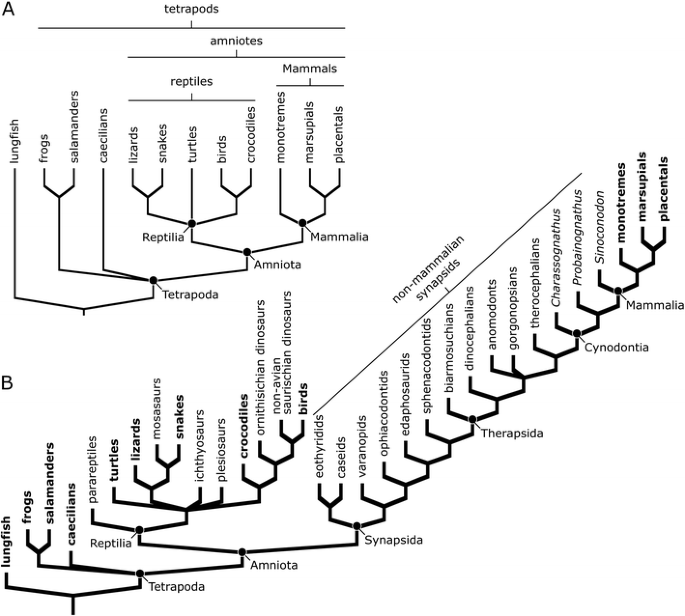
a Simplified phylogeny of living terrestrial vertebrates (or tetrapods). Note that the three living mammal groups (monotreme mammals, marsupial mammals, and placental mammals) all share a more than recent common antecedent with each other than whatever does with the reptiles and that mammals and reptiles represent separate lines of descent from a mutual ancestor. Likewise note how patterns of shared ancestry are used to delimit the groups Mammalia, Reptilia, Amniota, and Tetrapoda. The position of caecilians on this tree is uncertain; they may belong on the branch with frogs and salamanders or they may belong on the co-operative leading to the Amniota [east.g., compare the phylogenies of Ruta and Coates (2007) to that of Anderson et al. (2008)]. b Simplified phylogeny of tetrapods to which a number of extinct amniotes have been added. Groups with living members are shown in bold. Note that birds are most closely related to non-avian saurischian dinosaurs on this tree, reflecting that birds are descendants of a dinosaur antecedent. Also note the large number of extinct groups of non-mammalian synapsids, which are descendants of the common antecedent of all synapsids, and thus are more closely related to living mammals than they are to whatsoever reptiles. In turn, this fact means that terms like mammal-like reptile do not accurately describe these animals considering they are not part of the reptile line of descent. Dimetrodon is a sphenacodontid
Now, let usa add together some fossils to our evolutionary tree (Fig. 4b). A noteworthy modify in the reptile portion of the tree that takes place when we do this is that living birds now share a common ancestor with not-avian saurishcian dinosaurs. This is because birds are descendants of a group of saurischian ("cadger-hipped") dinosaurs called theropods, making them dinosaurs themselves and allowing us to draw a distinction between non-avian dinosaurs (i.e., all those dinosaurs that are not birds) and "avian dinosaurs," birds themselves (an first-class review of the dinosaurian origin of birds tin be constitute in Chiappe 2007). More important in the context of the current paper are the many groups of extinct synapsids and early mammals known from the fossil record that are added to the co-operative leading upward to extant mammals. All of the groups on this co-operative below the node labeled "Mammalia" are not-mammalian synapsids. That is, they are descendants of the well-nigh recent common ancestor of all synapsids, but non the virtually contempo mutual ancestor of all mammals.
In the past, non-mammalian synapsids were often colloquially referred to every bit mammal-like reptiles. They were "mammal-like" because paleontologists understood that they were related to mammals and provided insight into the latter group's evolution, but they were "reptiles" because they lacked key characters that divers mammals, such as a unmarried jaw bone or three middle ear bones. Examining the phylogeny in Fig. 4b shows why this terminology has been abandoned by scientists as tree thinking has become common and taxonomic groups have come to be divers by patterns of shared ancestry. Non-mammalian synapsids are descended from the most contempo common ancestor of all synapsids, and not the almost contempo common ancestor of reptiles, making them past definition part of a line of descent that is separate from all reptiles. The fact that some of the earliest synapsids, such as Dimetrodon (which is a member of the synapsid subgroup called sphenacodontids in Fig. 4b), superficially resemble living reptiles in some respects does not overturn this underlying pattern of mutual ancestry.
Tree thinking too helps to clarify the nature of the evolution of mammals and many of their distinctive characters. Using outdated taxonomic concepts and terminology such equally "mammal-like reptile" misfile the issue because they suggest that reptiles are ancestors of mammals. In turn, this tin pb to questions such as, "if reptiles are ancestors of mammals, why are reptiles even so alive today?" and "where are the missing links between reptiles and mammals?" Once more, the answers to these questions are obvious if we consult our evolutionary tree (Fig. 4b). Reptiles are non ancestors of mammals; they are role of a carve up line of descent from a common ancestor, and then their beingness in the modern world is no more surprising than the fact that you lot and your cousin both exist today. In that location are no "missing links" between reptiles and mammals for exactly the same reason. Because reptiles and synapsids (including mammals) are two carve up lines of descent, the link between the groups is the common ancestor they share (just every bit y'all and your cousin are linked by beingness descendants of your grandparents). The fossil record preserves a number of extinct species that inform us about the characteristics of the last mutual ancestor of reptiles and synapsids, equally well as fossil species that are almost the base of the reptile and synapsid lines of descent [see e.grand., Ruta and Coates (2007) for a sense of the variety of the species but earlier this split, and Benton (2005), Kemp (2005), and Prothero (2007) for information on the earliest synapsids and reptiles]. These fossils provide of import insights about what characters early members of both groups inherited from their common ancestor, which characters are new features that are unique to 1 grouping or the other, and the evolutionary and ecological context in which new characters and species evolved. Scientists use these indirect methods to understand the ancestors of groups of organisms because it is all but incommunicable to say with certainty whether a particular fossil is definitely an ancestor. However, by studying where various organisms fall on phylogenies and what characteristics the organisms possess, nosotros can get a good sense of what an ancestor was like even if nosotros cannot identify information technology exactly.
How to Recognize a Synapsid
A final important upshot to address in this department is the question of how scientists recognize which animals are part of the grouping Synapsida. In other words, what does it take to exist a synapsid? Once over again, tree thinking is critical to answering this question, as are the concepts of definition and diagnosis.
The definition of a named group of organisms describes the limits of membership of that grouping. With the rise of tree thinking, the definitions of groups take come to focus on patterns of descent from common ancestors, as we saw with the definition of Kielan-Jaworowska et al. (2003) of mammals quoted in a higher place. A similar definition for Synapsida could take the form of "all animals more closely related to Man sapiens than Terrapene carolina (the eastern box turtle)." However, although this definition tells united states of america who is a synapsid (whatsoever animate being that is more than closely related to H. sapiens than to the reptile T. carolina), it does not tell u.s.a. how to recognize synapsids if nosotros find them as fossils or in the living biota. This is where the concept of diagnosis comes into play: A diagnosis is a list of characters we can run across on a specimen that provide insight into the nature of its ancestry (additional data on the distinction of definition and diagnosis in the context of mammal development tin exist found in Rowe 1988; de Queiroz 1994, and Padian and Angielczyk 2007). Typically scientists develop diagnoses for groups by comparison the distribution of characters among dissimilar organisms to the relative placement of those organisms on an evolutionary tree. Through this procedure, they tin can determine which characters occur in merely descendants of a particular common ancestor and thus can be used to identify such descendants. A good instance of a diagnostic character that can be used to identify almost any synapsid is the presence of the so-chosen synapsid temporal opening, an opening on the side of the skull in the vicinity of where the jaw musculature attaches, which can exist establish (with slight modifications) in synapsids as distinctive as Dimetrodon and living mammals, including humans (Fig. 5). Useful diagnostic characters for living mammals include hair and the presence of mammary glands that let female mammals to secrete milk to nourish their offspring.
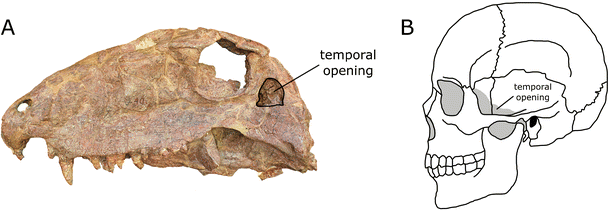
a Photograph of the left side of a fossil Dimetrodon skull (FMNH UC 40) showing the location of the synapsid temporal opening behind the eye socket. b Line drawing of a human skull showing the location of the synapsid temporal opening behind the eye socket. Jaw muscles attach to the skull in the vicinity of the temporal opening, and it is an important character that allows us to identify living and fossil synapsids. Images are not to calibration
Now that nosotros understand who synapsids are and where they autumn on the tree of life relative to other groups such as reptiles, allow united states of america plow to the topic of synapsid diversity and its implications for the evolution of many of the distinctive characters of mammals.
Tree Thinking, Synapsid Variety, and the Evolution of Mammalian Characters
Because of their close human relationship to living mammals and the fact that they provide a record of the evolutionary history of many mammalian characters, much research on non-mammalian synapsids is couched in the framework of mammal origins (e.thou., Sidor and Hopson 1998; Sidor 2001, 2003). Similarly, most pop accounts of synapsids make a point of describing the order in which different mammalian characters evolved and the evolutionary steps in the process. Such works are important because they present the parts of synapsid history that are nearly directly our own and shed light on what our very aboriginal ancestors were like. Notwithstanding, in the interest of brevity and simplicity, the total diverseness of non-mammalian synapsids is rarely addressed. This is unfortunate because although well-nigh people realize that living mammals vary from aardvarks and bats to whales and zebras, they are usually unaware of the fascinating array of shapes, sizes, and ways of life that non-mammalian synapsids evolved millions of years earlier the kickoff mammals appeared. On the occasions when they do run across some of this diversity, such as during museum visits, their unfamiliarity can atomic number 82 to confusion about how it pertains to mammal development. A complete review of synapsid multifariousness is beyond the telescopic of this newspaper, but a few examples will help to provide a sense of its breadth.
A Option of Synapsids
Eothyris (Fig. 6a) is one of the most primitive synapsids known (i.e., it falls very shut to the base of the synapsid co-operative of the tetrapod evolutionary tree) and is probably very similar to the mutual ancestor of all synapsids in many respects. Its teeth suggest that it was a carnivore, but considering Eothyris is known but from a skull, it is difficult to say much else about its mode of life. The only known specimen of Eothyris was nerveless in n-key Texas in rocks that are near 275 million years old.
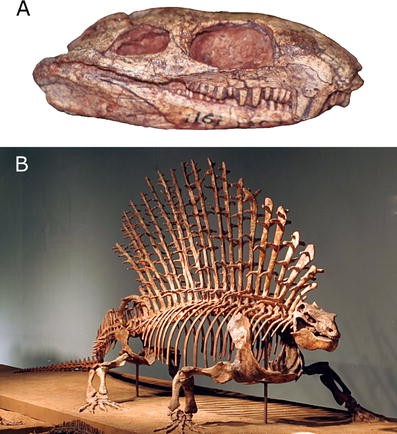
a The right side of the skull and jaw of Eothyris (MCZ 1161) and eothyridid synapsid. Eothyris is probably a skilful model for the common ancestor of all synapsids. b Skeleton of Edaphosaurus, an edaphosaurid synapsid. Edaphosaurus is 1 of the oldest known terrestrial vertebrate herbivores. This skeleton is on display at The Field Museum. Images are not to scale
Dimetrodon and Edaphosaurus (Figs. 1, 6b) are ii of the best-known and about distinctive early synapsids. Both animals are characterized by big sails on their backs, which are formed by elongated portions of their vertebrae, and which may have evolved as a means for them to more precisely regulate their trunk temperatures (Bennett 1996). Fascinatingly, evolutionary copse of synapsids suggest that Edaphosaurus and Dimetrodon evolved their sails independently, an example of the process of convergent evolution, where similar selective forces acting on distantly related organisms tin issue in the development of similar structures. Edaphosaurus also is noteworthy because it is one of the oldest known terrestrial vertebrates that is specialized for feeding on plants (Sues and Reisz 1998; Reisz 2006). Dimetrodon and Edaphosaurus are best known from fossil localities in the American southwest, particularly Texas, that range in age betwixt about 300 1000000 and 270 1000000 years in historic period (Reisz 1986).
Dinocephalians like Anteosaurus and Ulemosaurus (Fig. seven) are more advanced synapsids that are part of the synapsid subgroup chosen Therapsida (Fig. 4b). The Dinocephalia include both carnivores (similar Anteosaurus) and herbivores (like Ulemosaurus), and some members of the group are among the largest non-mammalian synapsids known, reaching sizes similar to living hippos. Although the grouping's history is comparatively brief (dinocephalian fossils are known from rocks spanning a narrow time interval between nearly 269 meg to 263 one thousand thousand years ago), it is represented by a variety of species known from China, Russia, South Africa, Republic of zimbabwe, and Brazil (Rubidge 2005). Some dinocephalians likewise evolved a number of skull specializations, such every bit increased bone thickness, that appear to be related to head-butting behaviors (Barghusen 1975).
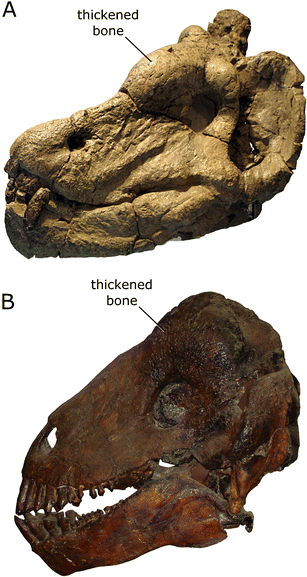
Dinocephalian specimens. a The left side of the skull and jaw of Anteosaurus (SAM-PK-K11296), a carnivorous dinocephalian. b The left side of the skull of Ulemosaurus (PIN 2207/111), an herbivorous dinocephalian. Note the thickened bone on the upper surface of each skull, which may accept been used in head-butting. Images are non to calibration
Anomodonts (Fig. viii) are one of the nearly successful groups of non-mammalian synapsids, and their remains have been discovered on every continent (King 1988, 1992). They are best known from the Heart Permian to the Tardily Triassic periods of Earth history (nearly 269 one thousand thousand to about 215 million years ago), although a controversial, fragmentary specimen from Commonwealth of australia hints that they might have survived until the Early Cretaceous, about 110 million years ago (Thulborn and Turner 2005). Anomodonts are noteworthy because they were among the most diverse and abundant herbivores of the Permian and Triassic, making them critical components of terrestrial ecosystems at these times. Well-nigh members of the group are toothless and possessed a turtle-similar beak in life that they used for chewing their food (Sues and Reisz 1998; Reisz and Sues 2000; Angielczyk 2004; Reisz 2006), although some species retained a pair of large tusks in their upper jaws (Fig. 8a). Anomodonts evolved a wide range of body sizes, with the smallest species being nigh the size of a living marmot and the largest reaching sizes comparable to hippos or rhinos today. They also evolved various lifestyles. For example, the anomodont Cistecephalus (Fig. 8b) and its close relatives appear to accept been specialized burrowers (Cox 1972; Cluver 1978), and the anomodont Lystrosaurus has been suggested to accept been semi-aquatic, much like living hippos (e.k., Germain and Laurin 2005; Ray et al. 2005).
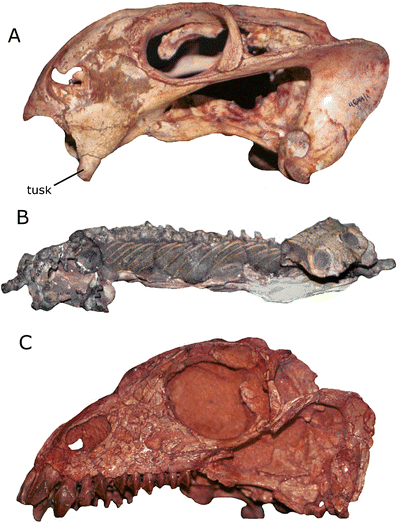
Anomodont specimens. a Left side of the skull of Delectosaurus (Pivot 4644/i). Note the presence of a tusk and the absenteeism of all other teeth. b Skeleton of Cistecephalus (BP/1/4086). Based on features of the front limb and skull, Cistecephalus is idea to have been a specialized burrowing animal (Cluver 1978). c Left side of the skull of Suminia (Pivot 2212/62). Suminia differs from most anomodonts by possessing numerous large teeth. Withal, many features of the skull indicate that it is more closely related to other anomodonts than to any other synapsids. Images not to scale
Gorgonopsians (Fig. ix) are an abundant and widespread group of carnivorous synapsids that are known from fossil localities in Russian federation and Africa dating to the Middle and Late Permian periods of Earth history (virtually 269 million to 251 1000000 years ago). Most members of the group were dog- or wolf-like predators, although some species reached sizes comparable to extant polar bears and grizzly bears [Sigogneau-Russell (1989) provides an overview of the multifariousness of gorgonopsian species; Kemp (1982) and Kemp (2005) give more than full general introductions to the group]. Gorgonopsians evolved a sabre-tooth advent with huge canine teeth, like to what is seen in the more familiar (and much younger) sabre-toothed true cat Smilodon. They may accept even possessed a specialized jaw joint that allowed them to open up their mouths extremely widely, thus enabling them to better employ their canines when attacking prey, merely also to shift their jaw forward so that their incisors (i.east., front teeth) could intermesh for more efficient cutting of meat once the casualty was subdued (Kemp 1969; Tatarinov 2000; although see Laurin 1998).
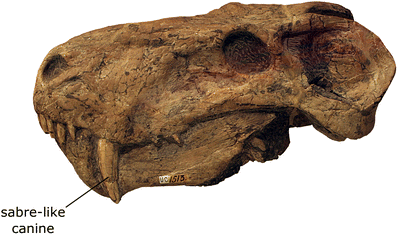
Left side of the skull and jaw of Lycaenops (FMNH UC 1513), a gorgonopsian synapsid. Notation the large, sabre-similar canine tooth
Therocephalians (Fig. 10) are another grouping of mostly cannibal synapsids that first appeared in the Middle Permian Flow of Earth history (well-nigh 269 million years ago), although they survived longer than gorgonopsians, finally going extinct in the Centre Triassic (almost 243 meg years ago). There is argue surrounding the exact relationship of therocephalians to the cynodonts, the non-mammalian synapsids most closely related to mammals. Many workers have treated therocephalians as a distinct grouping that is descended from a unmarried common ancestor and whose members are more closely related to each other than to whatsoever other synapsids (e.g., Hopson and Barghusen 1986; van den Heever 1994; Sidor and Hopson 1998; Rubidge and Sidor 2001; Sidor 2001, 2003). Even so, some authors have suggested that certain therocephalian taxa may exist more than closely related to cynodonts than to other therocephalians (Kemp 1972; Abdala 2007; Botha et al. 2007), a hypothesis that would imply that Therocephalia is not a natural grouping (i.due east., information technology does non consist but of descendants of a single mutual ancestor; see above). Well-nigh therocephalians were carnivores, although smaller species probable were insectivores, and some later on-occurring species may take been herbivores or omnivores. They also evolved a variety of body types, including wolf- and weasel-like forms (Fig. 10a, b). The therocephalian Euchambersia (Fig. 10c) is especially interesting considering several features of its skull and teeth are suggestive of it being venomous (Romer 1956; Kemp 1982, 2005; Hotton 1991; Folinsbee et al. 2007).
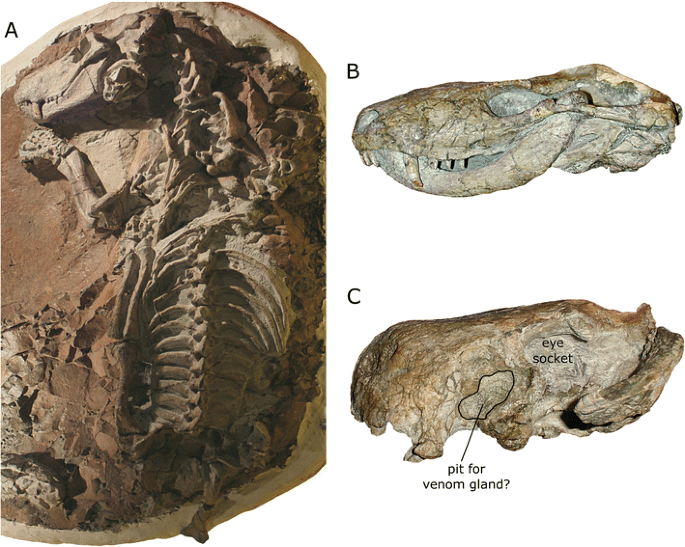
Therocephalian specimens. a Skeleton of Glanosuchus (SAM-PK-K7809) showing the wolf-like proportions typical of some members of the group. b Left side of the skull and jaw of Mirotenthes (UCMP V3695/40467), a typical pocket-sized therocephalian. c Left side of the skull of Euchambersia, a therocephalian thought to have been venomous (east.1000., Kemp 2005). Note the very different skull proportions compared to Mirotenthes and the presence of pit on the side of the snout that may have housed a venom-secreting gland. Images not to scale
Cynodonts are the not-mammalian synapsids well-nigh closely related to mammals. Indeed, mammals are part of the grouping Cynodontia (i.e., mammals are descendants of the mutual ancestor of all cynodonts), with cynodont lineages that diverged before the most recent common ancestor of mammals existence referred to as non-mammalian cynodonts. The oldest known cynodont was recently discovered in South Africa and was collected in rocks from the early Belatedly Permian Menstruation of World history (about 257 million years ago; Botha et al. 2007). Withal, cynodonts remained relatively rare components of terrestrial faunas until the Triassic period, when they became much more diverse and abundant. Early non-mammalian cynodonts, such as Procynosuchus (Fig. 11a) or Progalesaurus (Fig. 11b), tend to exist small insectivorous or cannibal animals, although in the Triassic, they evolved a wider range of body sizes and lifestyles. Because of their close relationship to mammals, cynodonts proceed to exist the subject of much inquiry, and this piece of work has done much to elucidate the relationships of the earliest mammals, equally well every bit the origins of many unique mammalian characters (e.thousand., come across reviews in Hopson 1991, 1994; 2001; Kielan-Jaworowska et al. 2003; Kemp 2005; Benton 2005; Prothero 2007).
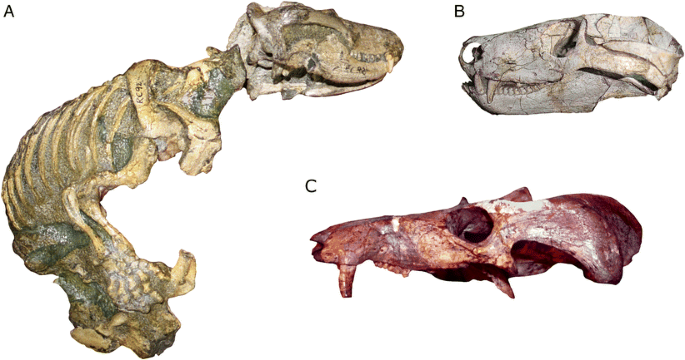
Not-mammalian cynodont specimens. a Partial skeleton of Procynosuchus (RC 92). b Left side of the skull and jaw of Progalesaurus (SAM-PK-K9954). c Left side of the skull of Diademodon (BSP 1934-Viii-xv). Procynosuchus and Progalesaurus are early not-mammalian cynodonts and were carnivores. Diademodon likely was an omnivore or herbivore. Images non to calibration
Now that we accept seen some of the diversity of non-mammalian synapsids, we can examine how paleontologists apply evolutionary trees to organize this diversity and to investigate where in synapsid history unlike mammalian characters evolved.
Using Tree Thinking to Organize Synapsid Diversity and Track Mammalian Characters
Because evolutionary trees depict patterns of descent from common ancestors, they are an extremely useful mode to relate the diverse shapes, sizes, and ways of life observed in a grouping of animals such as the synapsids to their evolutionary history. In turn, this allows usa to accurately decide where in synapsid history particular features of interest evolved, also as whether they were present in the ancestors of mammals or only in lines of descent that do not lead to mammals.
Recollect that when scientists construct a phylogeny, they consider a big number of characters and search for the tree that best explains the evolution of every bit many of those characters as possible. The resulting trees group species together based on inferred patterns of descent from common ancestors. Commonly, the species in particular groups resemble one another for the simple reason that they inherited many of their similarities from mutual ancestors. Notwithstanding, evolutionary trees frequently contain some surprises as well. For instance, detailed phylogenetic enquiry indicates that Edaphosaurus, which falls in the group called "edaphosaurids" in Fig. 4b, and Dimetrodon, which falls in the group called "sphenacodontids" in Fig. 4b, exercise not share a common antecedent that possessed a canvass on its back, despite the fact that both Edaphosaurus and Dimetrodon have sails on their backs. By group organisms together based on patterns of descent inferred from a big number of characters and not just a few potentially superficial similarities or differences, phylogenies provide a framework for request and answering deeper questions about diversity. For example, do all descendants of a common ancestor share a similar way of life, such as being terrestrial carnivores, or do some evolve to suit in other ecologies, such every bit an aquatic herbivore? Is there a correlation between the number of species in a grouping and the diversity of shapes, sizes, and ecologies plant in the group? Exercise some lines of descent from a common ancestor display higher rates of speciation than others? Practice superficially similar animals, such as Dimetrodon and Edaphosaurus, share a recent common ancestor or did they evolve their similarities independently?
In addition to their utility in studies of variety, phylogenies also can provide great insight into the evolutionary history of individual characters. By "mapping" a character of interest onto a phylogeny, we can not merely meet which species possess the character just also make inferences nigh where in the history of the group the character evolved and whether it is likely that the character evolved only once or multiple times [reviews of methods used for mapping the evolution of characters on evolutionary trees can be plant in Brooks and McLennan (1991) and Garland et al. (2005)]. The evolution of a bony secondary palate in different groups of synapsids provides a useful example of how tree thinking tin can elucidate the history of a graphic symbol.
All living mammals possess a bony secondary palate, a sheet of bone that separates the oral cavity from the nasal crenel. A number of hypotheses accept been put forward for the office of the secondary palate, including ameliorate respiratory function while chewing, perhaps in the context of increased metabolic rates (McNab 1978; Hillenius 2004); generation of negative pressure level in the oral fissure cavity while suckling (Maier et al. 1996; Maier 1999); or increasing the mechanical force of the snout (Thomasson and Russell 1986). It is also possible that more than one of these factors represents the selective pressure involved in the palate'south development. The oldest fossil mammals also possess secondary palates (Kielan-Jaworowska et al. 2003), simply if we look amidst non-mammalian synapsids, we find a mixture of animals that lack or possess secondary palates (Fig. 12a). Determining when in synapsid history this feature first evolved and whether it might have evolved more than once are potentially daunting tasks, merely the state of affairs becomes much clearer when we map the grapheme onto an evolutionary tree.
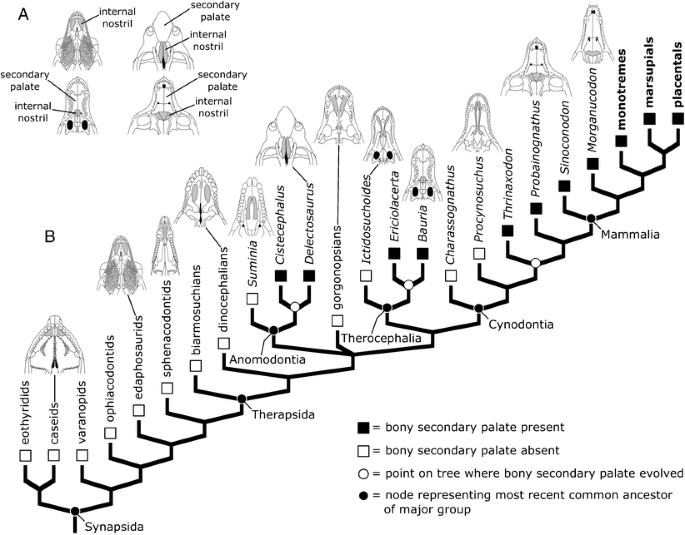
Bony secondary palate evolution in synapsids. a Drawings showing the bottom surface of the snout in four synapsids, i lacking a bony secondary palate, the others possessing a bony secondary palate. Note that the internal nostril (the opening through which air passes every bit it moves from the nasal cavity to the trachea and lungs, highlighted with gray shading) is much further dorsum on the skull in the synapsids with a secondary palate, finer isolating the path air takes as information technology enters the body from the mouth. In dissimilarity, the forward position of the internal nostrils in the synapsid lacking a secondary palate means that air must pass through the mouth on its mode to the lungs. b Simplified phylogeny of synapsids showing the distribution of bony secondary palates among major groups, as well equally comparative drawings of the snouts of various synapsids (internal nostrils highlighted with gray shading). Note that the distribution of secondary palates on this phylogeny implies that the graphic symbol evolved 3 separate times in synapsid history. Besides note that some synapsids with incomplete secondary palates, such equally Ictidosuchoides and Procynosuchus, help to certificate the evolution of this graphic symbol (run across text for details). Groups shown in bold include living representatives. Drawings were redrawn and modified from Efremov (1940), Romer and Price (1940), Kemp (1969), Hopson and Barghusen (1986), Rybczynski (2000), Angielczyk and Kurkin (2003), Maddin et al. (2008)
The first step in mapping the graphic symbol onto the tree is to note which of the animals listed at the tips of the branches possessed a bony secondary palate. The results of this step are shown in Fig. 12b. Now, nosotros will need to reconstruct whether the common ancestors of different groups also possessed a secondary palate. There are a number of ways to practise this, simply for simplicity, nosotros will utilise a method called parsimony, which seeks to minimize the number of evolutionary changes that are necessary to explain the distribution of the character on the tree. The results of this step reveal an interesting pattern: A bony secondary palate evolved multiple times in synapsids (Fig. 12b). The grapheme first evolved in the mutual ancestor of advanced anomodonts like Delectosaurus and Cistecephalus. It evolved a 2nd time in the common ancestor of advanced therocephalians such as Bauria and Ericiolacerta. Finally, a bony secondary palate evolved a third fourth dimension early on in cynodont history. Nosotros prefer this scenario to others because it requires the fewest evolutionary changes. For case, if nosotros hypothesized that a secondary palate evolved in the common ancestor of therocephalians and cynodonts, our tree implies that this feature would need to have been lost in several therocephalian subgroups, necessitating four evolutionary changes, as opposed to the three required by our preferred hypothesis. Moreover, the design indicates that mammals inherited their bony secondary palate from a cynodont ancestor, whereas the secondary palates of anomodonts and therocephalians represent split evolutionary innovations that are restricted to those groups, and thus are non directly relevant to the specific history of mammals. Finally, if we consider animals such as Procynosuchus or Ictidosuchoides, nosotros find that although they lack a complete secondary palate, their internal nostrils are partially covered over by an incomplete secondary palate. These forms and their position on the phylogeny are important because they help to document the evolutionary transition betwixt synapsids lacking secondary palates and those with complete secondary palates.
This tree thinking approach tin can be practical to any character and is very useful for answering a variety of evolutionary questions. For instance, to return to the question of whether our ancestors had a sail like Dimetrodon, graphic symbol mapping implies that the reply is no. Hypothesizing that the common ancestor of mammals and Dimetrodon possessed a sheet requires 2 evolutionary changes: ane change to the sailed condition and a second modify to the non-sailed condition in a more recent ancestor of mammals. In contrast, hypothesizing that a sail evolved in the immediate ancestor of Dimetrodon and its closest relatives and not in the common ancestor of Dimetrodon and mammals requires just i evolutionary change (i.e., the evolution of a sail in Dimetrodon'southward ancestor; no modify to the non-sailed condition is needed). Character mapping also tin inform u.s.a. about the club in which unlike characters evolved. For example, the method indicates that the novel jaw musculus organization plant in mammals (including the presence of a masseter muscle) evolved before two of the tiny middle ear bones, which were formerly part of the lower jaw, were fully incorporated into the hearing system (e.yard., Kemp 2005).
Conclusions
The development of mammals from non-mammalian synapsid ancestors is a significant topic for anyone interested in biology or paleontology. Not only is the process recorded in cracking item in the fossil record, giving the states much insight into the society in which characters changed and the functional and ecological contexts in which those changes occurred, merely it is also part of our history. Because non-mammalian synapsids are our relatives, learning well-nigh them helps to answer the question of "where did we come from?" as much equally studying fossil hominids or family unit genealogies. However, confusion often persists because of outdated ways of thinking about the topic.
Tree thinking is an first-class solution to the trouble because evolutionary trees provide an excellent framework for asking and answering evolutionary questions and are now a mutual tool used by biologists and paleontologists. For example, considering evolutionary trees describe patterns of descent from common ancestors, they are very useful for understanding the human relationship of non-mammalian synapsids to mammals (they are all descendants of a mutual ancestor), equally well equally how synapsids are related to reptiles (they are descendants of a mutual antecedent, but reptiles and synapsids are separate lines of descent). Similarly, phylogenies are very useful for organizing patterns of diversity in large groups, such as the Synapsida, and when combined with techniques such as character mapping, they tin can provide much insight into the evolution of unlike characters.
And so, when you are next confronted past not-mammalian synapsids, whether on tv set, at a museum, or in a book on prehistoric life, take a moment to use your tree thinking skills. They volition assist y'all to remember why Dimetrodon is not a dinosaur, why our ancestors did non have a sail like that of Edaphosaurus, and how scientists reconstruct the evolutionary history of mammalian characters.
References
-
Abdala F. Redescription of Platycraniellus elegans (therapsida, Cynodontia) from the Lower Triassic of Southward Africa and the cladistic relationships of Eutheriodontia. Palaeontology 2007;l:591–618. doi:ten.1111/j.1475-4983.2007.00646.10.
-
Anderson JS, Reisz RR, Scott D, Fröbisch ND, Sumida SS. A stem batrachian from the Early Permian of Texas and the origin of frogs and salamanders. Nature 2008;453:515–8. doi:10.1038/nature06865.
-
Angielczyk KD. Phylogenetic evidence for and implications of a dual origin of propaliny in anomodont therapsids (Synapsida). Paleobiology 2004;30:268–296.
-
Angielczyk KD, Kurkin AA. Phylogenetic analysis of Russian Permian dicynodonts (Therapsida: Anomodontia): implications for Permian biostratigraphy and Pangaean biogeography. Zool J Linn Soc 2003;139:157–212. doi:x.1046/j.1096-3642.2003.00081.x.
-
Barghusen HR. A review of fighting adaptations in dinocephalians (Reptilia, Therapsida). Paleobiology 1975;1:295–311.
-
Bennett SC. Aerodynamics and thermoregulatory function of the dorsal canvas of Edaphosaurus. Paleobiology 1996;22:496–505.
-
Benton MJ. Vertebrate palaeontology. 3rd edn. Oxford, UK: Blackwell; 2005.
-
Botha J, Abdala F, Smith R. The oldest cynodont: new clues on the origin and early on diversification of the Cynodontia. Zool J Linn Soc 2007;149:477–92.
-
Brooks DR, McLennan DA. Phylogeny, ecology, and beliefs: a inquiry program in comparative biology. Chicago: University of Chicago Press; 1991.
-
Cantino PD, de Queiroz G. International code of phylogenetic classification. http://world wide web.ohiou.edu/phylocode (2007).
-
Carroll RL. Problems of the origin of reptiles. Biol Rev Camb Philos Soc 1969a;44:393–432. doi:10.1111/j.1469-185X.1969.tb01218.ten.
-
Carroll RL. Origin of reptiles. In: Gans C, editor. Biology of the Reptilia. Book 1. London: Academic; 1969b. p. one–44.
-
Carroll RL. The ancestry of reptiles. Philos Trans R Soc Lond Ser B 1970;257:367–08.
-
Chiappe LM. Glorified dinosaurs: the origins and early on evolution of dinosaurs. Hoboken: Wiley; 2007.
-
Cluver MA. The skeleton of the mammal-like reptile Cistecephalus with evidence for a fossorial mode of life. Ann S Afr Mus 1978;76:213–46.
-
Cox CB. A new digging dicynodont from the Upper Permian of Tanzania. In: Joysey KA, Kemp TS, editors. Studies in vertebrate evolution. Edinburgh, UK: Oliver and Boyd; 1972. p. 173–89.
-
Cope ED. The theromorphous Reptilia. Am Nat 1878;12:829–30.
-
Darwin C. On the origin of species by means of natural selection, or the preservation of favoured races in the struggle for life. London: John Murray; 1859.
-
de Queiroz K. Replacement of an essentialistic perspective on taxonomic definitions every bit exemplified by the definition of "Mammalia.". Syst Biol 1994;43:497–510. doi:10.2307/2413548.
-
Efremov IA. Ulemosaurus svijagensis Riab., ein Dinocephale aus demn Ablagerungen des Perm der USSR. Nova Acta Leopold 1940;nine:155–205.
-
Felsenstein J. Inferring phylogenies. Sunderland: Sinauer; 2004.
-
Folinsbee Thousand, Müller J, Reisz RR. Canine grooves: morphology, role, and relevance to venom. J Vertebr Paleontology 2007;27:547–51. doi:x.1671/0272-4634(2007)27[547:CGMFAR]two.0.CO;2.
-
Garland T, Bennett AF, Rezende EL. Phylogenetic approaches in comparative physiology. J Exp Biol 2005;208:3015–35. doi:10.1242/jeb.01745.
-
Germain D, Laurin Yard. Microanatomy of the radius and lifestyle in amniotes (Vertebrata, Tetrapoda). Zool Scr 2005;34:335–50. doi:10.1111/j.1463-6409.2005.00198.10.
-
Gregory TR. Understanding evolutionary trees. Development: Education and Outreach 2008;121–37.
-
Hillenius WJ. Turbinates in therapsids: testify for Belatedly Permian origins of mammalian endothermy. Evolution Int J Org Evolution 2004;48:207–29. doi:10.2307/2410089.
-
Hopson JA. The mammal-like reptiles: a study of transitional fossils. Am Biol Teach 1987;49:sixteen–26.
-
Hopson JA. Systematics of the nonmammalian Synapsida and implications for patterns of evolution in snyapsids. In: Schultze HP, Trueb L, editors. Origins of the higher groups of tetrapods. Ithaca, NY: Comstock; 1991. p. 635–93.
-
Hopson JA. Synapsid development and the radiation of non-eutherian mammals. In: Prothero DR, Schoch RM, editors. Major features of vertebrate evolution. Short Courses in Paleontology 1994;7:190–219.
-
Hopson JA. Origin of mammals. In: Briggs DEG, Crowther PR, editors. Palaeobiology II. Oxford, UK: Blackwell Science; 2001. p. 88–94.
-
Hopson JA, Barghusen Hour. An analysis of therapsid relationships. In: Hotton Northward, MacLean PD, Roth JJ, Roth EC, editors. The ecology and biology of mammal-similar reptiles. Washington D.C.: Smithsonian Institution Press; 1986. p. 83–106.
-
Hotton N. The nature and diversity of synapsids: prologue to the origin of mammals. In: Schultze HP, Trueb L, editors. Origins of the higher groups of tetrapods. Ithaca, NY: Comstock; 1991. p. 598–634.
-
Huelsenbeck JP, Ronquist F. Bayesian analysis of molecular development using MrBayes. In: Nielsen R, editor. Statistical methods in molecular development. New York: Springer; 2005. p. 183–232.
-
Hull DL. Science as a process. Chicago: University of Chicago Press; 1988.
-
Kemp TS. On the functional morphology of the gorgonopsid skull. Philos Trans R Soc Lond B Biol Sci 1969;256:1–83. doi:10.1098/rstb.1969.0036.
-
Kemp TS. Whaitsiid Therocephalia and the origin of cynodonts. Philos Trans R Soc Lond B Biol Sci 1972;264:1–54. doi:x.1098/rstb.1972.0008.
-
Kemp TS. Mammal-like reptiles and the origin of mammals. New York: Bookish; 1982.
-
Kemp TS. The origin and evolution of mammals. Oxford, UK: Oxford Academy Printing; 2005.
-
Kielan-Jaworowska Z, Cifelli RL, Luo ZX. Mammals from the age of dinosaurs. New York: Columbia Academy Press; 2003.
-
King GM. Anomodontia. Handbuch der Paläoherpetologie 17C. Stuttgart: Gustav Fischer Verlag; 1988.
-
Male monarch GM. The palaeobiogeography of Permian anomodonts. Terra Nova 1992;four:633–xl. doi:10.1111/j.1365-3121.1992.tb00612.x.
-
Kitching IJ, Forey PL, Humphries CJ, Williams DM. Cladistics: the theory and practice of parsimony analysis. Syst Assoc Publ 1998;11:ane–228.
-
Laurin M. New information on the cranial anatomy of Lycaenops (Synapsida, Gorgonopsidae), and reflections on the possible presence of streptostyly in gorgonopsians. J Vertebr Paleontology 1998;18:765–76.
-
MacFadden BJ. Fossil horses: systematics, paleobiology, and evolution of the family Equidae. Cambridge, UK: Cambridge University Press; 1992.
-
Maddin HC, Sidor CA, Reisz RR. Cranial anatomy of Ennatosaurus tecton (Synapsida: Caseidae) from the Eye Permian of Russian federation and the evolutionary relationships of Caseidae. J Vertebr Paleontology 2008;28:160–80. doi:10.1671/0272-4634(2008)28[160:CAOETS]2.0.CO;2.
-
Maier W. On the evolutionary biology of early on mammals—with methodological remarks on the interaction betwixt ontogenetic adaptation and phylogenetic transformation. Zool Anz 1999;238:55–74.
-
Maier Due west, van den Heever J, Durand J. New therapsid specimens and the origin of the secondary hard and soft palate of mammals. J Zoological Syst Evol Res 1996;34:9–19.
-
Martin RA. Missing links. Sudbury: Jones and Bartlett; 2004.
-
McNab BK. The evolution of endothermy in the phylogeny of mammals. Am Nat 1978;112:one–21. doi:10.1086/283249.
-
O'Hara RJ. Homage to Clio, or, toward an historical philosophy of evolutionary biological science. Syst Zool 1988;37:142–55. doi:x.2307/2992272.
-
O'Hara RJ. Population thinking and tree thinking in systematics. Zool Scr 1997;26:323–9. doi:10.1111/j.1463-6409.1997.tb00422.x.
-
Padian G, Angielczyk KD. "Transitional forms" versus transitional features. In: Petto AJ, Godfrey LR, editors. Scientists confront intelligent blueprint and creationism. New York: Norton; 2007. p. 197–230.
-
Prothero DR. Development: what the fossils say and why it matters. New York: Columbia University Press; 2007.
-
Ray S, Chinsamy A, Bandyopadhyay S. Lystrosaurus murrayi (Therapsida, Dicynodontia): bone histology, growth, and lifestyle adaptations. Palaeontology 2005;48:1169–85. doi:10.1111/j.1475-4983.2005.00513.x.
-
Reisz RR. Pelycosauria. Handbuch der Paläoherpetologie 17A. Stuttgart: Gustav Fischer Verlag; 1986.
-
Reisz RR. Origin of dental apoplexy in tetrapods: bespeak for terrestrial vertebrate evolution? J Exp Zool 2006;306B:261–77, Molecular Development and Evolution. doi:10.1002/jez.b.21115.
-
Reisz RR, Sues HD. Herbivory in late Paleozoic and Triassic terrestrial vertebrates. In: Sues Hard disk, editor. Evolution of herbivory in terrestrial vertebrates. Cambridge, Britain: Cambridge University Press; 2000. p. ix–41.
-
Romer As. Osteology of the reptiles. Chicago: Academy of Chicago Pressp; 1956.
-
Romer AS, Price LI. Review of the Pelycosauria. Geological Society of America Special Paper 1940;28:ane–538.
-
Rowe T. Definition, diagnosis, and the origin of Mammalia. J Vertebr Paleontology 1988;viii:241–64.
-
Rubidge BS. Re-uniting lost continents—fossil reptiles from the ancient Karoo and their wanderlust. Due south Afr J Geol 2005;108:135–72. doi:10.2113/108.1.135.
-
Rubidge BS, Sidor CA. Evolutionary patterns amongst Permo-Triassic synapsids. Annu Rev Ecol Syst 2001;32:449–lxxx. doi:10.1146/annurev.ecolsys.32.081501.114113.
-
Ruta K, Coates MI. Dates, nodes, and graphic symbol disharmonize: addressing the lissamphibian origin trouble. J Syst Palaeontology 2007;v:69–122. doi:x.1017/S1477201906002008.
-
Rybczynski North. Cranial anatomy and phylogenetic position of Suminia getmanovi, a basal anomodont (Amniota: Therapsida) from the Late Permian of eastern Europe. Zool J Linn Soc 2000;130:329–73. doi:ten.1111/j.1096-3642.2000.tb01634.x.
-
Sidor CA. Simplification every bit a trend in synapsid cranial development. Evolution Int J Org Development 2001;55:1419–42.
-
Sidor CA. Evolutionary trends and the origin of the mammalian lower jaw. Paleobiology 2003;20:605–40. doi:10.1666/0094-8373(2003)029%3C0605:ETATOO%3E2.0.CO;2.
-
Sidor CA, Hopson JA. Ghost lineages and "mammalness": assessing the temporal pattern of character conquering in the Synapsida. Paleobiology 1998;24:254–73.
-
Sigogneau-Russell D. Theriodontia I. Handbuch der Paläoherpetologie 17B I. Stuttgart: Gustav Fischer Verlag; 1989.
-
Simpson GG. Diagnosis of the classes Reptilia and Mammalia. Evolution Int J Org Evolution 1960;xiv:388–92. doi:10.2307/2405982.
-
Sues Hd, Reisz RR. Origins and early evolution of herbivory in tetrapods. Trends Ecol Evol 1998;13:141–five. doi:ten.1016/S0169-5347(97)01257-three.
-
Tatarinov LP. Bug of the morphology of the theriodonts (Reptilia). Russ J Herpetol 2000;vii:29–40.
-
Thomason JJ, Russell AP. Mechanical factors in the evolution of the mammalian secondary palate: a theoretical analysis. J Morphol 1986;189:199–213. doi:x.1002/jmor.1051890210.
-
Thulborn T, Turner S. The last dicynodont: an Australian Cretaceous relict. Proc R Soc Lond B Biol Sci 2005;270:985–93. doi:10.1098/rspb.2002.2296.
-
van den Heever J. The cranial anatomy of the early on Therocephalia (Amniota: Therapsida). Ann Univ Stellenbosch 1994;1994:1–59.
Acknowledgments
Cheers are due to Don Prothero for organizing this special event of Development: Didactics and Outreach and for inviting me to contribute to it. I also give thanks curators, collections managers, and friends at the Bayerische Staatssammlung für Paläontologie und historische Geologie (BSP), the Bernard Price Institute for Palaeontological Inquiry (BP), The Field Museum (FMNH), the Iziko South African Museum (SAM), the Museum of Comparative Zoology (MCZ), the Palaeontological Institute (PIN), the Rubidge Collection (RC), and the University of California Museum of Paleontology (UCMP) for their assistance with the visits on which I took the photos in Figs. v, 6, 7, viii, 9, 10, and 11. Christian Kammerer graciously immune me to utilise the photos in Figs. 7b, 10c, and 11b. Audrey Aronowsky and Scott Buhrman commented on drafts of the manuscript. Christian Sidor and two bearding reviewers also provided helpful comments and suggestions.
Writer information
Affiliations
Respective author
Rights and permissions
Open Access This is an open up access commodity distributed under the terms of the Creative Commons Attribution Noncommercial License ( https://creativecommons.org/licenses/by-nc/2.0 ), which permits whatsoever noncommercial use, distribution, and reproduction in whatever medium, provided the original author(south) and source are credited.
Reprints and Permissions
Most this commodity
Cite this article
Angielczyk, Thou.D. Dimetrodon Is Not a Dinosaur: Using Tree Thinking to Understand the Ancient Relatives of Mammals and their Evolution. Evo Edu Outreach 2, 257–271 (2009). https://doi.org/x.1007/s12052-009-0117-iv
-
Received:
-
Accepted:
-
Published:
-
Issue Date:
-
DOI : https://doi.org/x.1007/s12052-009-0117-iv
Keywords
- Evolutionary tree
- Mammalia
- Mammal-like reptile
- Non-mammalian synapsid
- Permian
- Phylogeny
- Synapsida
- Tree thinking
- Triassic
alfarosmingthengs.blogspot.com
Source: https://evolution-outreach.biomedcentral.com/articles/10.1007/s12052-009-0117-4

0 Response to "Which Family Did Carnivorous Placental Mammals Evolve From"
Post a Comment